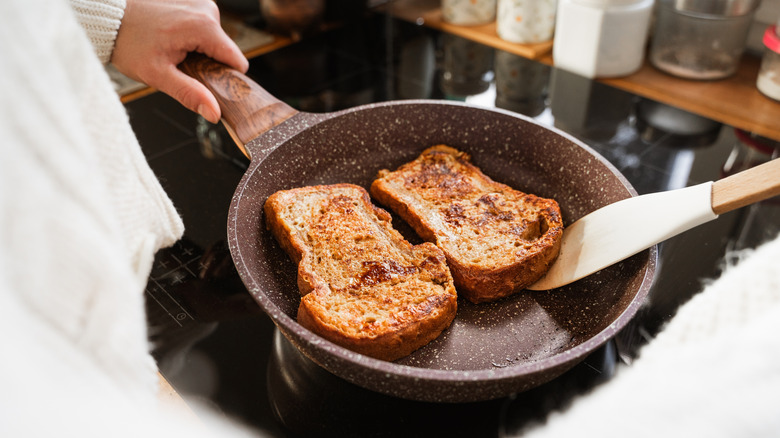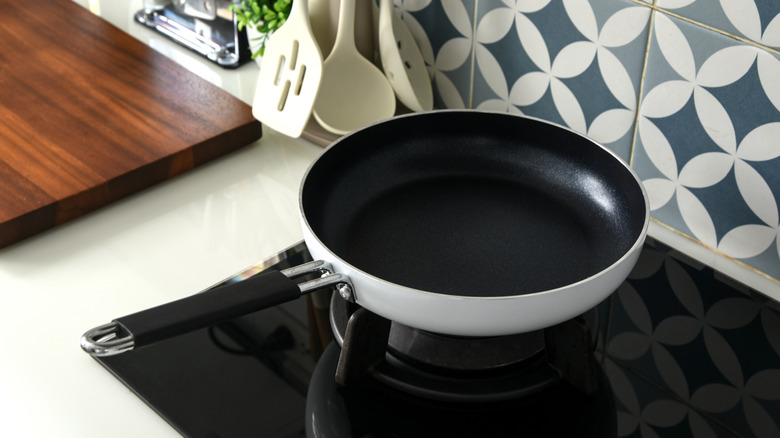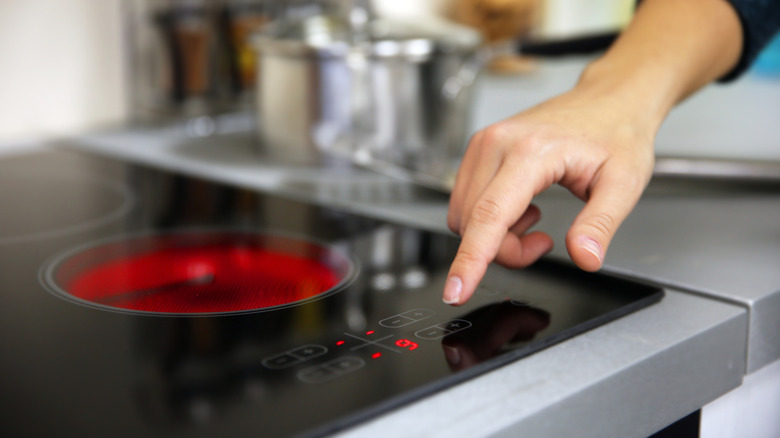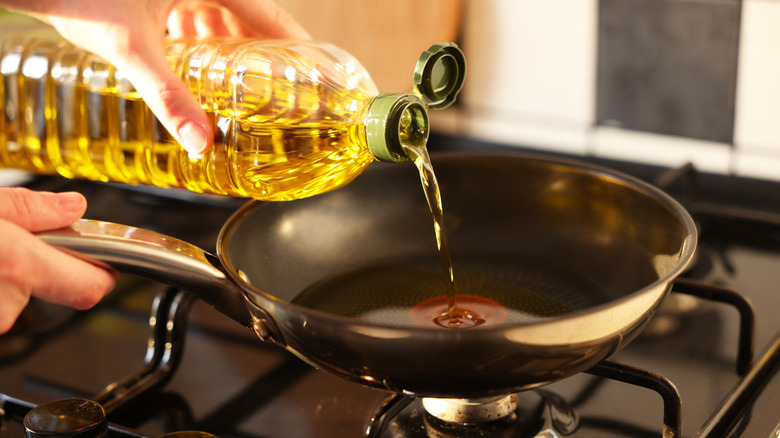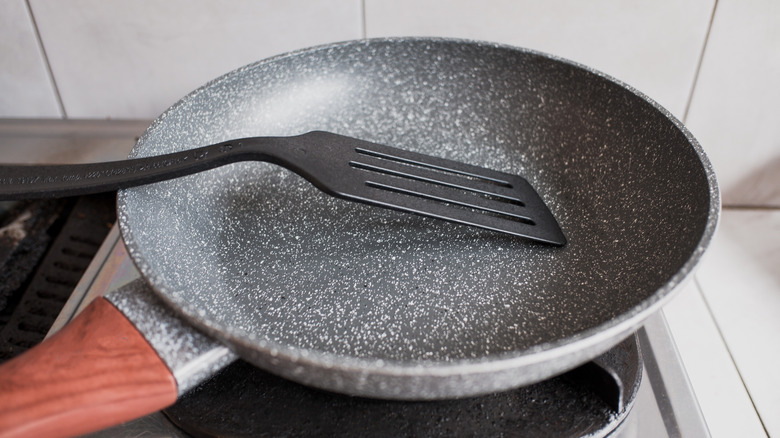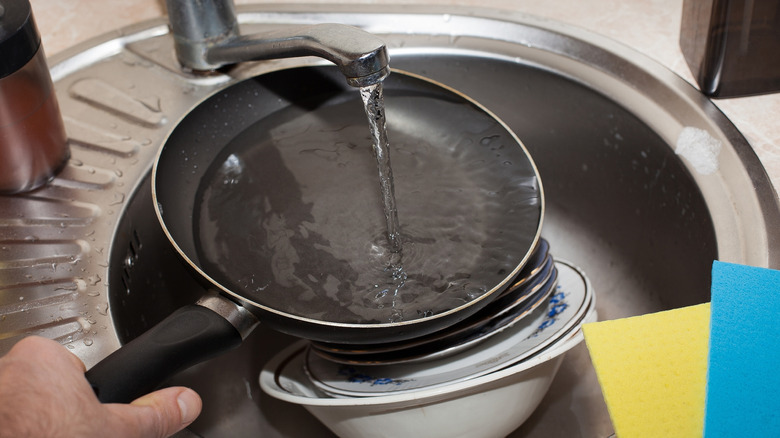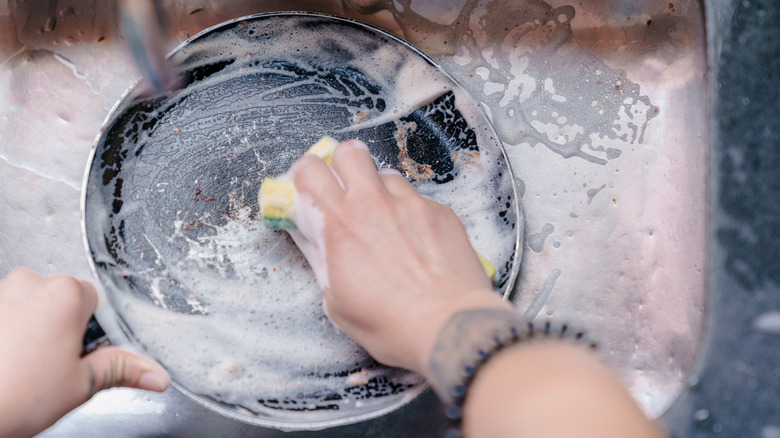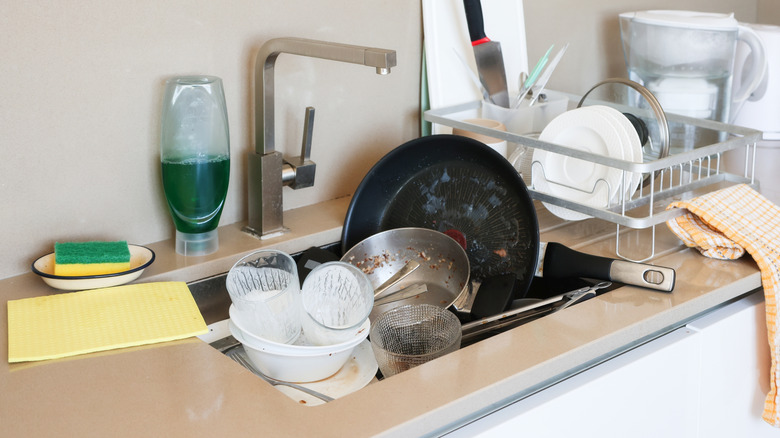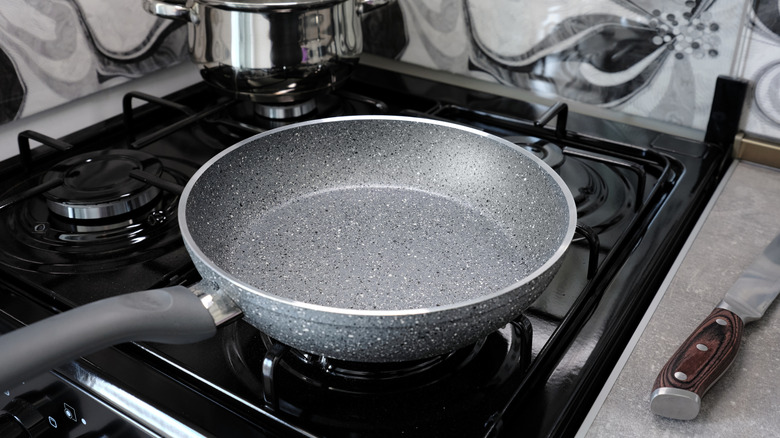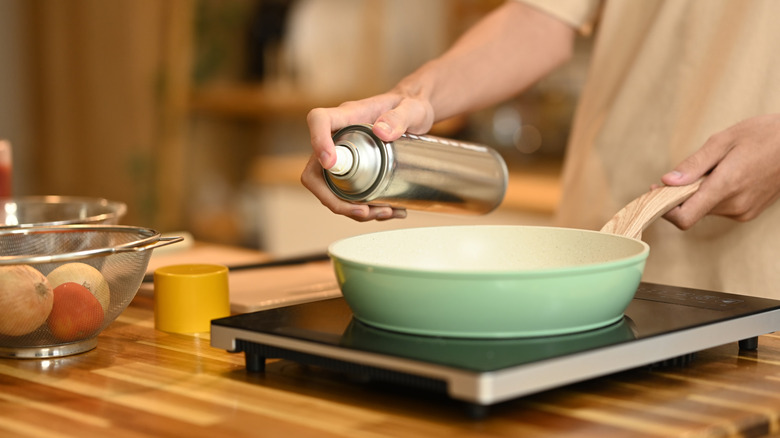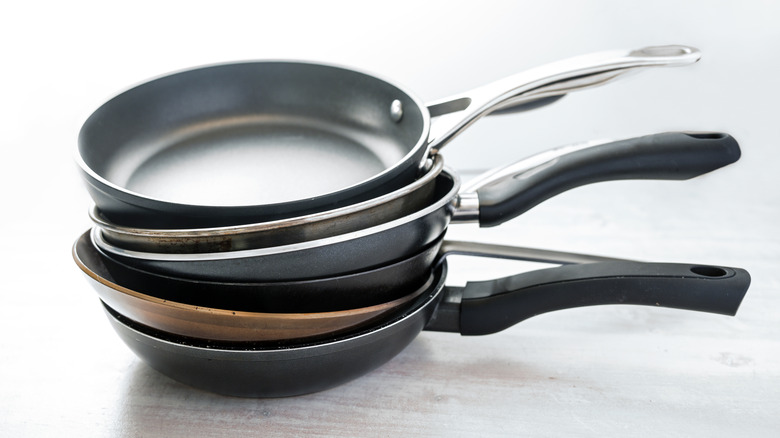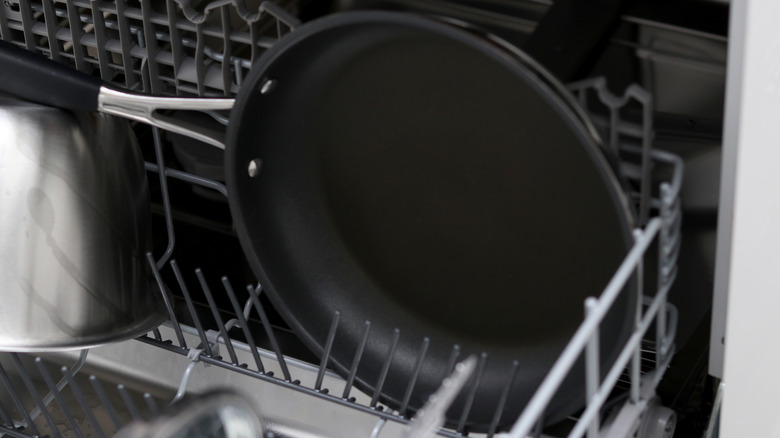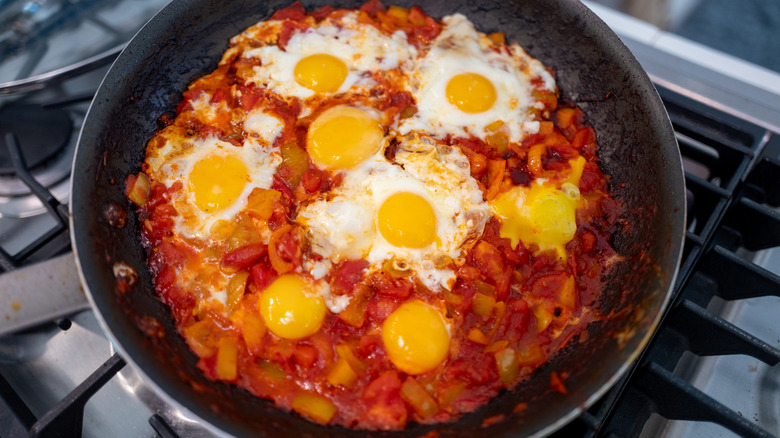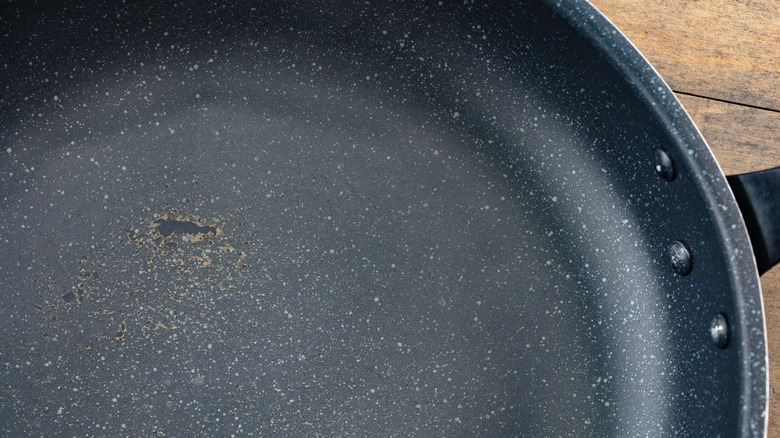The Biggest Mistakes People Make With Their Nonstick Pans
Your nonstick pan is a culinary workhorse. You can rely on it when you can't rely on any other cookware. It makes your life easier. Fried eggs? You got 'em in a flash, and you won't spend precious minutes at the sink after breakfast, trying to scrape stuck egg residue from the bottom of the pan, all thanks to your nonstick pan's precious Teflon coating. However, nonstick pans aren't without their faults.
The elephant in the room: Some may worry that Teflon isn't exactly safe to use. However, nonstick pans manufactured after 2014, in the United States, do not include the chemical known as PFOA (or perfluorooctanoic acid) that's been connected to increased risk of cancer and similar illness, thanks to a federal ban on nonstick coatings that contain the chemical. And, even if you're still worried about Teflon, you can buy nonstick pans made from other, growing-in-popularity materials, too, such as ceramic rather than regular nonstick cookware.
But with that out of the way, there's still more you have to look out for when cooking with nonstick. If you make some of the following big mistakes, you could ruin your pan or your food.
Not prepping the pan before first use
You probably know that you should season your cast iron cookware before the first use, but compared to nonstick pans, cast iron seems so finicky and difficult to use. Surely you don't need to take similar precautions with your nonstick pan. You should be good to just pop it out of its packaging and get to cooking — right?
Unfortunately, no. Even though nonstick pans will make your life infinitely easier, they do require some prep work before first use. Otherwise, you could end up with a nonstick pan that's stickier than it should be. So, gently wash your nonstick pan with warm water and dish soap, dry it off, and then season the pan. It's not going to take very long, but it'll help your nonstick cookware last longer and work at its best, right from the start.
After washing, just coat the cookware with a thin layer of vegetable or canola oil, all across the nonstick surface. Then, place it on the stovetop at medium heat for a minute or two. That's all! Allow it to cool, clean off the oil, and you're ready to cook. You can repeat this process about twice a year to keep your nonstick pans in good shape, or any time you notice the nonstick surface is getting a little sticky.
Cooking over high heat
Often, the worry about cooking over high heat with a nonstick pan stems from the outdated idea that your nonstick pan is going to harm you via all those dangerous Teflon chemicals that are released. However, as we already discussed, the chemical that poses the most threat to you is PFOA, which is no longer in new, American-made nonstick cookware. Still, though, today's modern coatings may continue to break down at high heats, causing temporary symptoms known as "Teflon fever." The good news? You're never going to use your nonstick pans at the high heats necessary for the modern coatings to start to break down: 570 degrees Fahrenheit.
Rather than worrying about your health, your main concern regarding using nonstick pans over high heat should be degradation. High heat can wear down the nonstick coating over time, making the pan less non-stick the more you use it. As such, keep the nonstick cooking to medium or low heat.
Using low smoke point oils
Cooking oils with lower smoke points, like extra virgin olive oil or unrefined coconut oil, are often viewed as healthier, but you should avoid using them in your nonstick pans. Low smoke point oils begin to burn or smoke at a lower temperature, and if you accidentally push one of those oils past their smoke point, then they could leave behind a burnt residue that ultimately reduces your nonstick cookware's nonstick properties, while also negatively impacting the taste of whatever it is you're cooking. In fact, you could end up completely and irreparably damaging your nonstick pan for good.
As such, choose oils with a higher smoke point and, if you absolutely must use a lower smoke point oil like extra virgin olive oil in your nonstick pan, keep the cooking to a low heat. High smoke point cooking oils that you can use instead include refined avocado oil, sunflower oil, soybean oil, or corn oil.
Using metal utensils
You're flipping some pancakes or sauteeing some vegetables and you don't even think about it. You need to flip that pancake and you reach for a metal spatula. You need to stir the veggies around so you just grab a fork. However, metal utensils and nonstick pans are a no-go, incompatible combination. Metal can quickly scrape the nonstick surface, damaging it and making it no longer nonstick. Instead, whenever you're cooking in a nonstick pan, always use nylon, silicone, or wooden utensils.
But what if you've already committed this nonstick cookware faux pas? If you've already scratched up your nonstick pan, you can still continue using it, under certain circumstances. If the scratches are surface-level and superficial, then you could go on using the pan, just realize that it won't be as non-stick as it once was. However, if those scratches are deep, then they pose more of a risk than just a sloppy pancake that won't flip correctly. The scratches could harbor bacteria.
Sticking a hot pan under cold water
You've just finished cooking your meal, and now you're ready to clean up. Your nonstick pan is still pretty hot, but you need to give it a quick clean so your chores are done for the day. However, hold on just a minute before you stick that pan underneath a stream of running cold water, cooling it quickly so you can wash it with ease.
When you quickly expose a very hot piece of cookware to suddenly cooler temperatures, they're likely to warp. You might see this happen right before your very eyes, for example, if you take a hot, cheap sheet pan from a 450-degrees Fahrenheit oven and place it on a trivet on the counter to cool. The pan may make a loud popping sound or even jump. The same thing will happen to nonstick pans. From there, if the pan is warped, sure, you can still use it. However, it's never going to be the same. Misshapen, it's not going to sit flush with your stovetop any longer, and that means it won't heat evenly, making cooking in it possibly more trouble than it's worth.
Cleaning the pan with steel wool
Ideally, after you carefully let your nonstick pan cool and are ready to clean it, the pan's nonstick properties will make it so that there's hardly anything left to clean. Just give it a quick swipe with a sudsy dish towel, rinse, and dry. Sometimes, though despite your best efforts, your nonstick pan may still show off a little oil residue or some food particles after use. In this case, you may be tempted to reach for the tool that you know is going to absolutely obliterate any and all stuck-on gunk: steel wool. However, this is the one item you should never, ever use to clean sticky residue from a nonstick pan. Just like metal utensils can scratch and damage your pan's nonstick surface, so can steel wool.
So what should you do if you do encounter buildup that just won't come free with a little elbow grease? First, try scraping away any buildup by using your handy silicone or wooden spatula or utensil and some warm water. If that doesn't work, pour enough water into the bottom of the pan to cover it, and then add in a few spoons of baking soda and vinegar, in equal amounts. Stirring, heat this until boiling, for a few minutes, and then use that same silicone or wooden utensil to scrape the residue away. Then, wash the pan like you normally would.
Letting the pan sit in the sink
If you don't want to go through all that trouble of boiling a mixture of vinegar and baking soda to clean your nonstick pan from any built-up gunk, you may think that you can use the ol' favorite "I just don't want to clean these dishes now" trick: leaving it to soak overnight in the sink. However, resist the temptation to put off today's chore to tomorrow.
If you leave your nonstick pan sitting in the sink to "soak" overnight, even if you don't fill it with water, you could end up inadvertently damaging the nonstick coating, as well as just making the job more difficult for yourself, once you do clean the pan. For example, if the food you cooked in the pan last was acidic, those acids could begin eroding the nonstick coating, even just overnight. Additionally, the food could cement itself further to the pan, necessitating a rougher cleaning process that risks damage.
Preheating an empty pan
Generally, preheating your cooking pan before adding your food is a good idea. It allows the pan itself to come up to your desired heat faster, as it's not sitting there filled with cold, possibly refrigerated or even frozen food. It leads to more uniform cooking. It leads to a shorter cooking time. It can even help with a pan's nonstick properties. However, never preheat a nonstick pan completely empty. Doing so can damage the nonstick coating. Additionally, if you do have an old nonstick pan that still contains some of those dangerous PFOA coatings, or a pan that was manufactured in a country that still allows for PFOA coating use, then preheating an empty nonstick pan raises the risk of some the associated chemicals leeching into the air.
This doesn't mean you need to avoid preheating your nonstick pan completely. Instead, before turning on the burner, just add a bit of oil to the bottom of the pan. Then turn on the burner and wait for the pan and oil to come to heat. (And remember to use an oil with a high smoking point!)
Using cooking sprays
When choosing which oil to add to your nonstick pan before you preheat, you might automatically reach for your favorite cooking spray. After all, cooking sprays are what you use to keep your baked goods from sticking, and using a cooking spray limits the overall amount of oil you're consuming. Win-win, right? Well, actually, cooking sprays can be particularly damaging to nonstick pans.
Cooking sprays often include lecithin. While lecithin is something you typically don't need to worry about, it can deteriorate a nonstick coating, as it creates a sticky residue that's difficult to remove. Additionally, cooking sprays often burn at lower temperatures than many oils. When they do, again, they leave behind a residue that's difficult to clean off and ultimately reduces your pan's nonstick properties. Furthermore, just the act of spraying oil — any oil — on your nonstick pan can result in very fine particles that stick to the pan and burn as well. In short, when adding oil to your nonstick pan, you can't cut corners by trying to use a spray. A high smoke point oil, poured into the pan, is the only way to go.
Stacking nonstick pans for storage
Yes, you could even be potentially making a big nonstick pan mistake while you're not even using it. If you're storing your nonstick pans atop one another, then you're putting them at risk for scratching and scraping. Sure, storing pans this way may save valuable cabinet space, but it could leave you with nonstick pans that aren't even worth using any longer. In fact, if you store your nonstick pans stacked, you could even void your manufacturer's warranty, if your pans came with one — that's how potentially damaging stacking pans for storage can be.
So what should you do instead? Hanging your nonstick pans on hooks in a pantry is one option. If you really need to stack the pans, because you're short on space, you can place a protective barrier between each pan. Towels or a thick layer of paper towels will work, so long as the entirety of the nonstick surface is covered.
Putting a nonstick pan in the dishwasher
The majority of nonstick cookware is not dishwasher safe, so don't even think you can toss that pan into the bottom rack and expect it to hold up over time. There are many reasons why the dishwasher is an unwelcoming environment for your nonstick pans. The high temperatures and high-pressure water are too rough for the nonstick coating. Many dishwasher detergents are too abrasive for the coating, too. Then, think about how you typically load your dishwasher; it's probably pretty packed in there, right? When you shouldn't even be nesting your nonstick pans for storage, you certainly won't want to cram them into the dishwasher alongside all your other cookware.
In total, putting your nonstick pan in the dishwasher could lead to coating degradation, peeling, discoloration, and warping. Really, all you need to clean a nonstick pan is a little bit of mild dish soap and warm water, plus a soft dish towel. If you've taken proper care of your nonstick pan and not built up gunk from burnt oil and similar mistakes, then you should never need an extreme clean anyway.
Cooking the wrong food in your nonstick pan
While nonstick pans work wonders for foods prone to sticking, like eggs, or foods that you need to flip, like crepes or quesadillas, they're not a great fit for every single dish you cook up. In fact, cooking certain foods in your nonstick pans could damage them. Meanwhile, other foods just aren't ideal for cooking in nonstick pans due to the high heat or oil they require.
For example, if you're searing a steak, you're probably not going to be able to get the nice char that you'd want, from a nonstick pan. You'd be better off going with cast iron. Meanwhile, acidic foods can break down your pan's nonstick coating. As such, avoid high-acid foods like tomatoes, or dishes that incorporate vinegar. Making something that requires a lot of constant stirring or whisking? Probably don't want to use your nonstick pan for that. And if you're making anything that requires deglazing or creating a pan sauce using up all those little browned bits? Also not a good fit for nonstick pans, as not only are they not ideal for searing and browning, so you'll get fewer of those tasty browned morsels overall, but they also just aren't suited to the necessary high heat.
Continuing to use a nonstick pan once it starts to peel
It's always smart to know when to throw in the towel and admit that your nonstick pan has seen the last of its days. You might already just want to get rid of any nonstick pans that may predate the U.S. ban on PFOA, regardless of the condition the pan is in. However, for other, newer pans, there are some telltale signs that they need to go.
For example, if your pan's coating is peeling off, it's done for. Not only does that peeling impact the nonstick properties, but the peeled bits can end up in your food — not exactly something you want to eat. Additionally, as mentioned, if the pan's coating contains any deep gouges, go ahead and toss it, rather than risk bacteria growing in those grooves and then showing up in your food. Even if your pan's coating isn't visibly falling apart, if it's turned a dark color, that's a sign the coating is wearing away, too. Of course, if your pan is rusting anywhere, that's no good, either.
